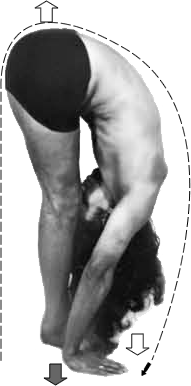Padahastasana is the third entry in the Surya Namaskar sequence. Unlike some postures, the Sanskrit for this pose is very simple: Pada means foot, hasta means hand, asana means posture; so, hand to foot pose or standing forward fold. Notice that I wrote fold rather than bend. I find that thinking of this as a forward bend encourages rounding the spine. Thinking of this as a fold encourages keeping the spine long rather than simply bending at the middle of the back.
This is one of the many ego tripping postures we will review. Ego shows up not because this is one of the “cool poses” but because there is a tendency to either think we should be folding much further than we are or to write the pose off by thinking, “I can’t touch my toes.”
Padahastasana, Alignment
On an exhale, fold forward. Keep your eyes on your finger tips (which are extended overhead from ardha anuvittassana) as you fold. Bend the knees slightly. Place the hands on the floor with the thumbs next to the little toes. Press down into the feet while extending up the legs and down along the spine, moving the crown of the head toward the floor. Shift the weight slightly into the balls of the feet while gently pressing the forehead toward the shins. Do not struggle or strain into the pose.
The energetic extension in this posture is almost circular in nature with the extension up the legs and then heading back down the spine. As the weight shifts into the balls of the feet, the toes have a tendency to grip strongly into the mat. Keep the toes soft.
Padahastasana, Modification
I have heard so often, “I’m not flexible enough for Yoga” which is like someone saying, “I’m too out of shape to exercise” or “My leg isn’t broken enough to see a doctor.” The truth is, you may not be flexible enough for one of the popular Yoga magazines to think you belong on their cover but you are plenty flexible to fold forward, reach your arms toward the floor and bend your knees a little. There are two ways to modify this posture: First, bend your knees deeply. If balance is an issue, the second modification is for you. Use a chair to your side so you can hold and stabilize yourself or place the chair directly in front of you, seat toward you. Place your hands on the chair seat and fold forward.
Padahastasana, Intention
The intention of padahastasana is surrender to and acceptance of physical, not mental, limits. Physical limits must be respected, ignoring them or pushing through them is a fast track to injury. Accepting physical limits, moving right up to the physical edge of a posture and sitting there, allows us to slowly stretch those limits and increase our flexibility and strength. Criticizing ourselves for having physical limits is like being angry because part of the front flowerbed is weedy. Rather than be angry, tend to the flowerbed and nurture it; tend to the physical limits by keeping the body well nourished and slowly stretching into those physical limits.
Mental limits are the stories we tell ourselves and they are usually as fictional as any fairy tale. This doesn’t mean that we should simply ignore them or even push through them. Just let them vanish. Mental limits quickly dissolve when exposed to the reality of a physical experience. “I can’t touch my toes” can no longer exist when your fingers brush your toes. Ego might step right in and start with “Yeah but . . . .my legs aren’t straight, my back is too rounded, my nose isn’t touching my shins.” Recognize this as just an attempt to create more limits, breathe and relax with it. If you are starting to think that mental limits are more difficult than physical limits, you are absolutely right.
Experiment
Simple experiment for today. Set a timer for 1-2 minutes. Fold into padahastasana. Notice two things. First notice what happens to your breath as you stay folded forward. Second, notice what stories your mind starts making. If you feel the need to force yourself deeper into the pose, breathe, relax and let gravity do all the work. Repeat this experiment tomorrow and note the difference. Share what you find here in the comments!
Jai Bhagwan!

